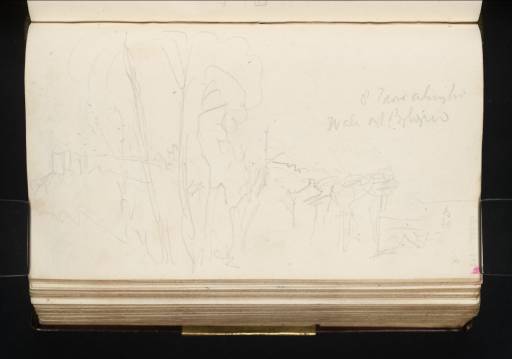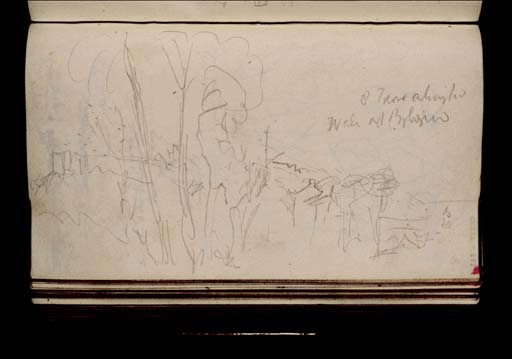Joseph Mallord William Turner The Walls of Boulogne to the South-West beyond Trees, with the Sea in the Distance Below 1825
Image 1 of 2
Joseph Mallord William Turner,
The Walls of Boulogne to the South-West beyond Trees, with the Sea in the Distance Below
1825
Joseph Mallord William Turner 1775–1851
Folio 241 Verso:
The Walls of Boulogne to the South-West beyond Trees, with the Sea in the Distance Below 1825
D19319
Turner Bequest CCXIV 241a
Turner Bequest CCXIV 241a
Pencil on white wove paper, 95 x 155 mm
Inscribed by Turner in pencil ‘8 Tower[s] al[...] | Wall at Bol[?ogne]’ centre right
Inscribed by Turner in pencil ‘8 Tower[s] al[...] | Wall at Bol[?ogne]’ centre right
Accepted by the nation as part of the Turner Bequest 1856
References
1909
A.J. Finberg, A Complete Inventory of the Drawings of the Turner Bequest, London 1909, vol.II, p.660, CCXIV 241a, as ‘A view’.
With the page turned horizontally, Turner’s first view of Boulogne in this sketchbook is largely occluded by trees. It appears to be from the Calais road, heading south-south-west with the sea below to the right. The fortified medieval wall referred to in the scrawled note forms a rectangular perimeter around the elevated citadel of the haute ville, originally a Roman camp, high to the east of the lower town and harbour at the mouth of the River Liane where it enters the English Channel; the coastline runs north-north-east to south-south-west in the immediate vicinity. Turner had presumably travelled south-west about twenty miles overland from Calais (see under folio 237 recto; D19310). He also spelled ‘Boulogne’ without its first ‘u’ in clearer notes in the contemporary Holland, Meuse and Cologne sketchbook (Tate D19539, D19550; CCXV 81a, 90). D19539 is one of several comparable sketches it contains looking from this side, unimpeded by foliage; see also folios 242 verso and 243 recto (D19321–D19322) in the present book.
Boulogne (sometimes ‘Boulogne-sur-Mer’ to distinguish it from Boulogne-Billancourt, the Parisian suburb) has since spread in all directions into the surrounding countryside, precluding equivalent views to some of Turner’s from inland, and the city’s harbour and the area around it saw much expansion and change later in the nineteenth century. The harbour itself and surrounding housing were severely damaged soon after D-Day in 1944, and effectively nothing remains of what Turner recorded in that area except St Nicholas’s Church, a landmark in several sketches, but his viewpoints can be established by comparison with maps of the time. One recurring feature is the framework of the telegraph station which stood at the end of the western pier, at about the point where the Capitainerie tower now stands on reclaimed land above the Quai de l’Amiral Huguet; another is the long, low bathing establishment on the beach just to the east on the opposite side of the Liane channel, later developed as a casino and now the site of the Nausicaa Centre National de la Mer aquarium.
Using both the present sketchbook (see also folios 242 recto–248 verso; D19320–D19333) and the larger Holland, Meuse and Cologne book (see under Tate D19416; Turner Bequest CCXV 8a), Turner drew around the harbour, along the beaches and cliffs to the north and south, and from then open countryside to the south-east and north-east of the old town, as well as a few studies immediately around and within its walls. He also took in the lost Fort de la Crèche, on rocks just offshore below cliffs to the north, and its counterpart, Fort de l’Heurt (which he labelled ‘Fort Napoleon’), which survives as a precarious ruin off Le Portel, about two miles south-west of the harbour mouth.
The coastal forts are indicative of the important role Boulogne played in the recent Napoleonic Wars. The Royal Navy had already attacked a potential invasion flotilla assembled here in 1801, and between 1803 and 1805 the surrounding area became a vast military camp with various fortifications and earthworks, as a base for the conquest of Britain; the harbour was redeveloped with a semi-circular basin alongside the main channel. The operation never materialised, owing to the demands of other campaigns and the Royal Navy’s control of the seas, sealed by the Battle of Trafalgar in October 1805. Meanwhile the construction of the Colonne de la Grande Armée, overlooking the Channel on the heights to the north-east, was begun in 1804, albeit it was only completed to its full height of 50 metres (165 feet) after the wars, and eventually topped by a statue of the Emperor.1 Napoleon’s legacy and Turner’s interest is evident in sketchbooks from his tours around much of Europe, and directly and indirectly in his watercolours and exhibited paintings; see Elizabeth Jacklin’s Introduction to the ‘Napoleon Recollections c.1841–2’ section of this catalogue.2
By 1825, after ten years of peace, the fishing port of Boulogne was developing towards being a tourist destination, with the opening of the bathing facilities a few months before Turner’s autumn visit, and the following year a regular steamer service to London began.3 There are two sheets of studies (each with two views) of the nearby coast and forts in ink on blue paper, likely from later in the 1820s (Tate D20291–D20292; Turner Bequest CCXXIV 1, 2), but despite numerous subsequent tours around and through France, Turner’s next identified views of Boulogne, in combinations of slight pencil and loose, atmospheric watercolour, were made almost twenty years later in the Boulogne sketchbook, one of two large ‘roll’ books he took with him on his penultimate visit to France (and indeed the Continent) in May 1845; see in particular Tate D35402, D35416–D35417, D35419, D35424–D35425, D35427, D35430–D35431, D35433; Turner Bequest CCCLVIII 1, 14, 15, 16, 18v, 19, 20, 21v, 22, 23).
Intervening developments are discussed in John Chu’s Introduction to the Boulogne sketchbook in the present catalogue. The most conspicuous was the as yet domeless drum of the basilica of Notre-Dame, under construction between the late 1820s and the 1870s within the old town walls, on the site of the ancient cathedral demolished in the Revolutionary period. Some of the subjects are comparable with those drawn on the present tour, as noted in individual entries. A separate, late watercolour study of a sunset, lacking any obvious topographical context, is inscribed ‘Bol’ (Tate D35962; Turner Bequest CCCLXIV 119); it awaits detailed cataloguing. There are also rapid pencil coastal studies in the vicinity in the 1845 Dieppe and Kent sketchbook (Tate D35487, D35573, D35636; Turner Bequest CCCLXI 1, 49, 84).
Tate also holds a detailed 1846 pencil drawing of the old town from inland by the Victorian history and genre painter Eyre Crowe (1824–1910; Tate T08911), and three subjects engraved after Turner’s contemporary Clarkson Frederick Stanfield, for the book Stanfield’s Coast Scenery. A Series of Views in the British Channel (London 1836). Boulogne, Upper Harbour (Tate impressions: T05679, T05680) is a northward view down the River Liane, which does not have a direct counterpart here; Boulogne, Old Pier (T05681, T05682) includes a detailed depiction of the telegraph tower; and Boulogne, Wreck on the Coast (T05683, T05682) shows what is likely the Fort de l’Heurt in the background.
Boulogne is the last Continental subject in the largely continuous sequence inferred from most of this exceptionally long sketchbook, and Turner likely sailed directly from here for home, as there is no indication of a return to Calais. Where he landed is unclear, as the first proposed English subjects immediately following as foliated are Faversham and nearby Whitstable on the northern Thames Estuary coast of Kent (see under folios 249 recto and 251 recto respectively; D19334, D19338), followed by a long sequence at Dover and Deal, and a few at Folkestone. Both Dover and Folkestone are also seen at the beginning of the book; see its Introduction for further discussion.
Matthew Imms
September 2020
See Pierre-André Wimet ‘Chapitre VIII. Boulogne et le rêve conquérant de Napoléon’ in Alain Lottin ed., Histoire de Boulogne-sur-Mer, 2014 (online ed. 2016), OpenEdition Books, accessed 28 August 2020, https://books.openedition.org/septentrion/7587 .
See also Luke Herrmann, ‘Napoleon Bonaparte (1769–1821)’ and Alfred (Fred) Bachrach, ‘Napoleonic Wars (1793–1815)’ in Evelyn Joll, Martin Butlin and Herrmann eds., The Oxford Companion to J.M.W. Turner, Oxford 2001, pp.[197]–8.
See ‘Chronologie’ in Lottin 2014, OpenEdition Books, accessed 28 August 2020, https://books.openedition.org/septentrion/7606 .
How to cite
Matthew Imms, ‘The Walls of Boulogne to the South-West beyond Trees, with the Sea in the Distance Below 1825 by Joseph Mallord William Turner’, catalogue entry, September 2020, in David Blayney Brown (ed.), J.M.W. Turner: Sketchbooks, Drawings and Watercolours, Tate Research Publication, March 2023, https://www


